Comparison of AA battery chemistries
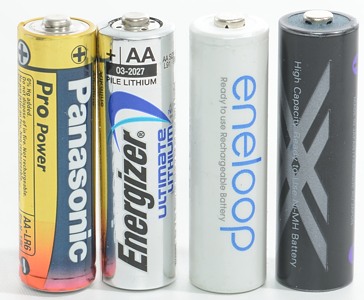
In this article I will look at some different AA battery chemistries: zinc-carbon, Alkaline, Lithium, NiMH, NiZn, LiIon. Zinc-carbon, alkaline and Lithium are primary batteries, i.e. not rechargeable, NiMH,NiZn and LiIon is rechargeable.
The standard size of AA batteries is up to 50.5 mm long (including plus pole) and 14.5 mm in diameter, this was standardized in 1947 by IEC (but the battery was in use long before that).
Naming
The AA battery has been around a long time and during that time many different names has been used, both from manufacturers and from standard organizations.
IEC uses R6 for the AA battery size and then places a letter before, depending on chemistry, the most common are: LR6=Alkaline AA, FR6=Lithium AA, HR6=NiMH AA
ANSI uses 15A for alkaline AA, 15LF for lithium AA and 1.2H2 for NiMH AA.
Some of the other names used for the AA cell size is: penlight, mingon, MN1500, M
Voltage, capacity and other info
Zinc-carbon

These batteries are rated 1.5 volt, their actual capacity is seldom specified, because it varies with load.
The Varta datasheet for these batteries specifies 1000mAh when discharge at unspecified low current. They are rated for a 36 months self life and can be used from -10°C to 50°C.
The battery weights about 18 gram.
Today they are very rare, because they have been replaced by alkaline batteries, that has considerable better performance.
Alkaline

These batteries are rated 1.5 volt, their actual capacity is seldom specified, because it varies with load.
Energizer has a datasheet with specifications and their AA has about 2900mAh at 25mA load, but only about 1400mA at 500mA load.
According to Energizer the Alkaline battery will work down to -18°C, but with reduced capacity.
The shelf life can be up to 10 years.
The battery weights about 23 gram.
Alkaline batteries is also known to leak and destroy equipment, even unused cells can leak.
Lithium

These batteries are rated with 1.5 volt and has around 3000mAh.
According to Energizer the battery will work down to -40°C, but with reduced capacity.
The shelf life can be up to 15 years.
Unloaded voltage will be around 1.8 volt.
The battery weights about 15 gram.
The lithium batteries compared here is lithium-iron (Li-FeS2) batteries, there does also exist lithium batteries with 3 volt, they are usual sold in other sizes (CR123, CR2), but can also be found in AA size, but cannot be used instead of ordinary AA batteries.
NiMH (nickel–metal hydride)

These batteries are rated with 1.2 volt, capacity is marked on the cell and is usual in the 2000mAh to 2700mAh range.
According to Sanyo the battery will work down to 0°C, but with reduced capacity.
The shelf life it not rated for rechargeable, but depending on type they can retain charge from a few weeks to a couple of years.
The battery weights 26 to 30 gram.
NiZn (Nickel–zin)

These batteries are rated with 1.6 volt, energy (not capacity) is marked on the cell and is around 2500mWh (The reason for using mWh instead of mAh is probably because the mAh is rather low).
These batteries have been around for some time, but are not very popular, this may have to do with their rather short lifespan in typical AA applications.
They requires a special NiZn charger.
The battery weights around 25 gram.
LiIon (Lithium-ion)

LiIon are usual rated 3.6 or 3.7 volt, this is not really fit for AA replacement, but some manufacturers have added electronic to bring the voltage down.
The batteries cannot be charged on any normal charger, but requires a special charger, for these cells that means a Kentli charger, but there is also usb rechargeable cells around (There is a micro usb connector on the cell).
Due to the electronic these batteries will also have some extra self discharge.
The above brand weights about 19 gram.
Comparison
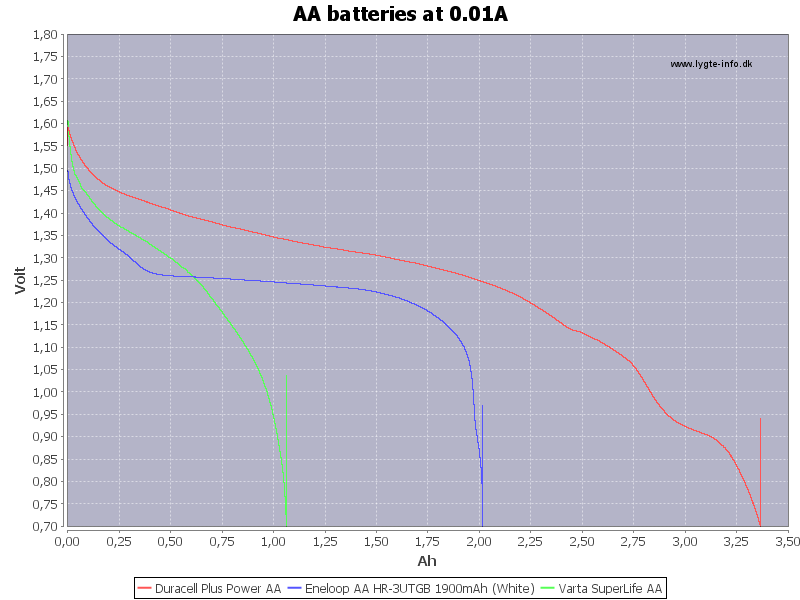
First curve is with very low current, i.e. for equipment that can run a week or more continuous on a battery.
At this low current alkaline works really well, it has the highest voltage and most capacity
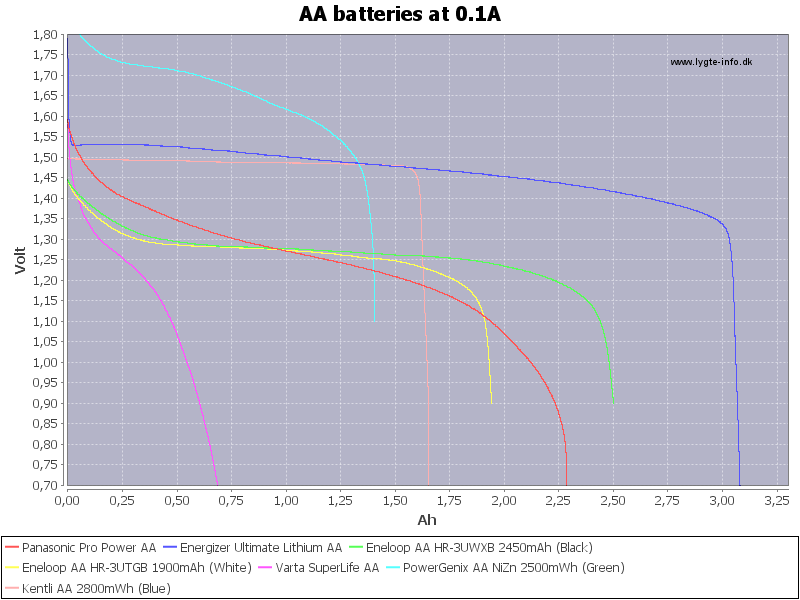
Increasing the current a bit and alkaline is not a clear winner anymore. The alkaline battery lasts about 22 hours (2.2Ah at 0.1A), half the time is has higher voltage than the NiMH batteries, the rest of the time lower.
The lithium battery stays close to 1.5 volt and it is also the battery that delivers most energy.
Zinc-carbon cannot compare at all.
NiZn has the highest voltage, but also the lowest capacity.
LiIon matches Lithium for voltage, but not for capacity.
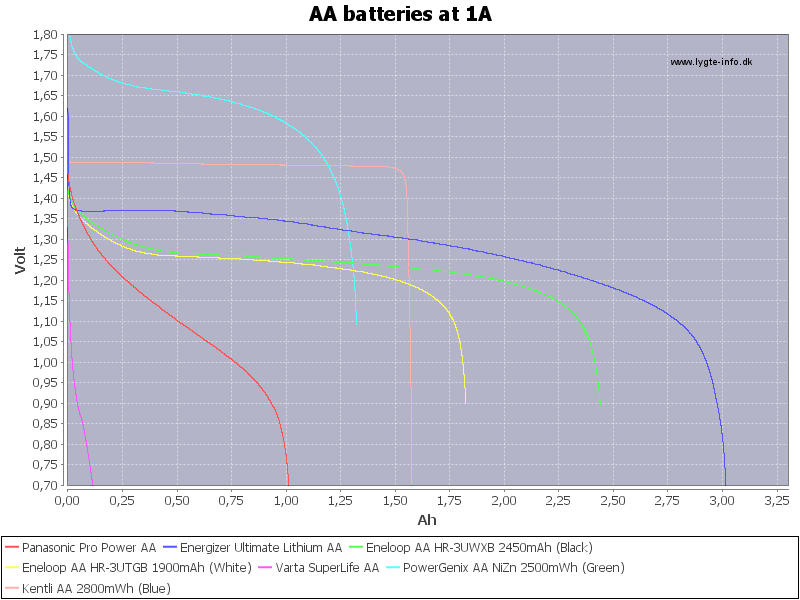
Increasing the current to 1A is very hard on the alkaline battery, the voltage drops below the NiMH after a few minutes and continues down.
NiMH works just as well at 1A as 0.1A, the voltage and capacity is only slightly lower.
Again the lithium battery is the best for capacity, the capacity drop from 0.1A to 1A is small, but voltage is starting to drop.
Zinc-carbon cannot compare at all and is mostly useless at this current.
NiZn works fine at 1A, the highest voltage and nearly same capacity as at 0.1A
LiIon with the electronic can maintain a constant voltage, but has slightly less capacity.
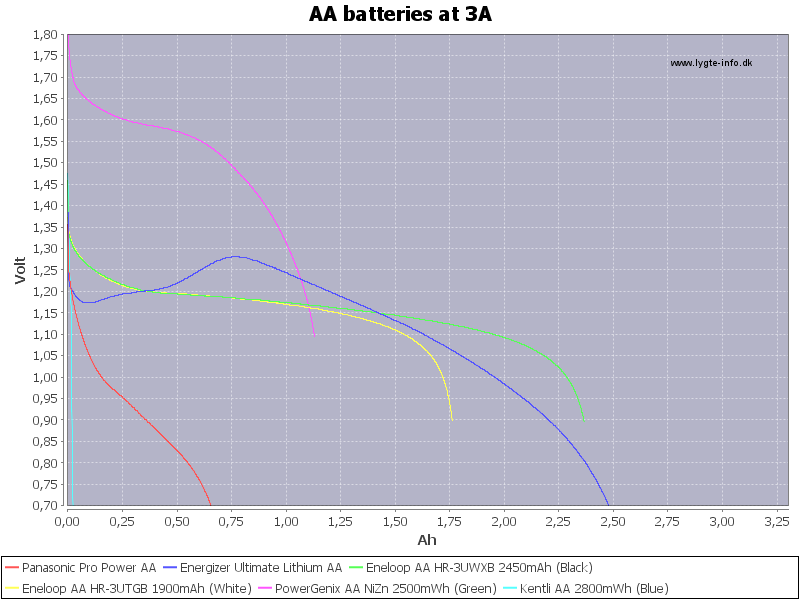
At 3A the alkaline battery cannot do much.
NiMH works fine, but the voltage and capacity is lower
The lithium cell is also having problems, first the voltage drops, then it increase again while the cell heats.
Zinc-carbon cannot be used at 3A.
NiZn has lower voltage, but handles 3A fine.
The electronic in the LiIon cell is overloaded and cannot deliver anything.

The capacity shows how much current is in the batteries.

With energy it is the product of voltage and current that is summed, a buck or boost can use this energy, i.e. it can use extra voltage for more brightness or runtime.

This table is just the capacity converted to time.
Conclusion
The voltage printed on the cells, do not have much relation to actual voltage when using the cell.
Alkaline marked with 1.5 volt has lower voltage than NiMH marked with 1.2 volt at higher loads (Like a flashlight on high). At very low loads alkaline will be better than NiMH.
Lithium is the top performing chemistry for high voltage, high capacity and fairly high current at the same time (It is also the best at low temperature).
NiZn has too high voltage and with the short lifetime it is not really interesting.
LiIon may be interesting for devices that requires more voltage than NiMH can provide, but watch out for the self discharge.
Battery reviews
I have only linked reviews of the shown batteries, for most types I have tested more brands.
AA rechargeable
Eneloop AA HR-3UTGB 1900mAh (White)
Eneloop AA HR-3UWXB 2450mAh (Black)
PowerGenix AA NiZn 2500mWh (Green)
Kentli AA 2800mWh (Blue)
AA primary
Panasonic Pro Power AA
Energizer Ultimate Lithium AA
Varta SuperLife AA
Compare any AA/AAA battery with reviews
AA/AAA comparator













